
Appearances, as the old saying goes, can be deceiving. That certainly applies to our gardens and more specifically the soil in them.
It is a common misconception that just because plants - be they ornamentals, fruit and veg or even lawns - appear to be thriving, the soil they grow in must be free from pollution and contamination. Not much could be further from the truth.
The fact is that the presence of potentially harmful heavy metals (lead, mercury and cadmium et cetera), various hydrocarbons, asbestos and other elements that can pose significant risks to our health can exist in the soil seemingly without affecting what’s growing in it. Whether these ended up in the soil because of past industrial land use in the area, proximity to heavy traffic or former mining sites, flooding and even intensive farming activities, their presence can have a calamitous impact on our wellbeing.

If these things are present, we risk ingesting them by eating things grown in the contaminated soil, inhaling dust particles kicked up by the wind or our digging and even through our skin upon contact. The risks range from minor irritation to kidney and bone diseases through to neurological damage, various cancers and ultimately even death.
But don’t take our word for for it. A European Commission report into the impacts on human health of soil contamination sums up some of the most common - and potentially severe - risks:
“Health problems from cancers (arsenic, asbestos, dioxins), to neurological damage and lower IQ (lead, arsenic), kidney disease (lead, mercury, cadmium), and skeletal and bone diseases (lead, fluoride, cadmium) are serious issues, that in many cases we have yet to address.
“Heavy metals and persistent organic chemicals are of particular concern. Human activity introduces heavy metals (such as cadmium, arsenic and mercury) to our soils through mining, smelting, industry, agriculture and burning fossil fuels.
“Our disposal of materials containing heavy metals – a long list which includes paint, electronic waste, and sewage – also contributes to the burden of heavy metal contamination. Organic chemicals are also part of our industrial legacy, and many are still widely used today.”

On a considerably gentler note, and with much less at stake, the same applies to soil fertility. Again, just because the majority of plants seem to be doing relatively well, does not necessarily mean that the soil has sufficient supplies of nutrients to allow the things we grow to thrive to their full potential. Or that the type of soil we have - be that its pH, texture or organic matter content - lends itself to growing the things we want to grow.
There’s sometimes a very good reason why our attempts never seem to match the glory on display on seed packets or in splashy magazine images. Or, even more annoyingly, what the neighbours have on display in their gardens.
So, as spring and another planting season approach, use soil testing to unlock its secrets and, ultimately, ensure that our gardens thrive. Safely.

Robert Galster is the co-founder of Safe Soil UK, Britain’s premier convenience soil testing company.
Whether it’s to check fertility or investigate for potential contamination, Safe Soil UK has your soil-testing needs in hand. www.safesoil.co.uk


